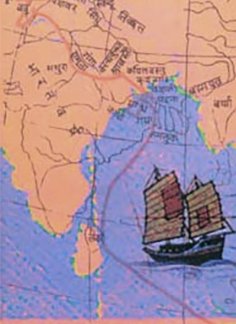Rajasevaka, Rājasevaka, Rajan-sevaka: 8 definitions
Introduction:
Rajasevaka means something in Hinduism, Sanskrit, the history of ancient India. If you want to know the exact meaning, history, etymology or English translation of this term then check out the descriptions on this page. Add your comment or reference to a book if you want to contribute to this summary article.
In Hinduism
Natyashastra (theatrics and dramaturgy)
Source: Wisdom Library: Nāṭya-śāstraRājasevaka (राजसेवक) refers to a “king’s officer” who can be assigned the role of an assesor (prāśnika) of dramatic plays (nāṭaka) according to the Nāṭyaśāstra chapter 27. These assessors (e.g., the veśyās) are to point out the faults of a dramatic performance (rājasevakas) as well as the merits of actors (nartaka) whenever a controversy (saṃgharṣa) arises among persons ignorant of the nāṭyaśāstra.

Natyashastra (नाट्यशास्त्र, nāṭyaśāstra) refers to both the ancient Indian tradition (shastra) of performing arts, (natya—theatrics, drama, dance, music), as well as the name of a Sanskrit work dealing with these subjects. It also teaches the rules for composing Dramatic plays (nataka), construction and performance of Theater, and Poetic works (kavya).
India history and geography
Source: Cologne Digital Sanskrit Dictionaries: Indian Epigraphical GlossaryRāja-sevaka.—(IE 8-5), same as Rāja-puruṣa, Rājakīya or Rāja-satka. Note: rāja-sevaka is defined in the “Indian epigraphical glossary” as it can be found on ancient inscriptions commonly written in Sanskrit, Prakrit or Dravidian languages.

The history of India traces the identification of countries, villages, towns and other regions of India, as well as mythology, zoology, royal dynasties, rulers, tribes, local festivities and traditions and regional languages. Ancient India enjoyed religious freedom and encourages the path of Dharma, a concept common to Buddhism, Hinduism, and Jainism.
Languages of India and abroad
Sanskrit dictionary
Source: Cologne Digital Sanskrit Dictionaries: Shabda-Sagara Sanskrit-English DictionaryRājasevaka (राजसेवक).—m.
(-kaḥ) A courtier, a royal attendant. E. rāja, and sevaka a servant.
Source: Cologne Digital Sanskrit Dictionaries: Cappeller Sanskrit-English DictionaryRājasevaka (राजसेवक).—[masculine] a king’s servant.
Source: Cologne Digital Sanskrit Dictionaries: Monier-Williams Sanskrit-English Dictionary1) Rājasevaka (राजसेवक):—[=rāja-sevaka] [from rāja > rāj] m. a k°’s servant, [Kathāsaritsāgara; Bhāgavata-purāṇa]
2) [v.s. ...] a Rājput, [Pañcatantra]
Source: Cologne Digital Sanskrit Dictionaries: Yates Sanskrit-English DictionaryRājasevaka (राजसेवक):—[rāja-sevaka] (kaḥ) 1. m. A courtier.
[Sanskrit to German]
Sanskrit, also spelled संस्कृतम् (saṃskṛtam), is an ancient language of India commonly seen as the grandmother of the Indo-European language family (even English!). Closely allied with Prakrit and Pali, Sanskrit is more exhaustive in both grammar and terms and has the most extensive collection of literature in the world, greatly surpassing its sister-languages Greek and Latin.
See also (Relevant definitions)
Partial matches: Rajan, Sevaka, Raja.
Starts with: Rajasevakanam-vasatidanda-prayanadandau-na-stah.
Full-text: Rajapurusha, Rajakiya, Raja-satka, Jitakashin, Prashnika.
Relevant text
Search found 3 books and stories containing Rajasevaka, Rājasevaka, Rajan-sevaka, Raja-sevaka, Rajansevaka, Rājan-sevaka, Rāja-sevaka; (plurals include: Rajasevakas, Rājasevakas, sevakas, Rajansevakas). You can also click to the full overview containing English textual excerpts. Below are direct links for the most relevant articles:
History of Indian Medicine (and Ayurveda) (by Shree Gulabkunverba Ayurvedic Society)
Chapter 18 - People and their Professions < [Part 4 - Some Aspects of Life in Caraka’s Times]
Mudrarakshasa (literary study) (by Antara Chakravarty)
6. Subhāśitas occuring in Mudrārākṣasa < [Chapter 5 - Adoption of Style and Language in Mudrārākṣasa]
Natyashastra (English) (by Bharata-muni)